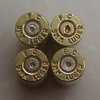Had the idea (After the .32 Long primer testing) to do one in 9MM. I sorted out some FC cases, picking only the FC with flt case heads and no .FC or .FC. cases. I should have sorted out more than I did so I could get the weight spread down more, but I didn't, and I am not going to go sort more out now, so it is what it is. Cases were 55.40 Grs to 59.56 Grs. A 4.16 Gr spread. Really wanted it smaller, but this will have to do.

The test load this time is a plinker load using 3.9 Grs of N320 and an X-Treme 124 Gr plated HP loaded @ 1.060.
I loaded ten each of Fed 100, S&B SPP, CCI 500, Win WSP, & Fed 200 (Old mild small rifle primer. Fed 200 is now listed as a small pistol mag primer. I have no idea if the mix is the same.)

I also loaded ten each of Fed 205, S&B SRP, CCI #41, Win WSR, & Wolf SRM (Magnum meaning thick cup for autos)

Separated in baggies, all marked of course.



Lots of rain here, not sure when I will get to the range.

The test load this time is a plinker load using 3.9 Grs of N320 and an X-Treme 124 Gr plated HP loaded @ 1.060.
I loaded ten each of Fed 100, S&B SPP, CCI 500, Win WSP, & Fed 200 (Old mild small rifle primer. Fed 200 is now listed as a small pistol mag primer. I have no idea if the mix is the same.)

I also loaded ten each of Fed 205, S&B SRP, CCI #41, Win WSR, & Wolf SRM (Magnum meaning thick cup for autos)

Separated in baggies, all marked of course.



Lots of rain here, not sure when I will get to the range.

